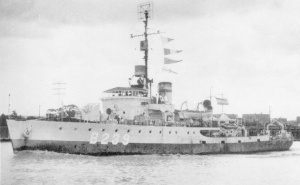HMAS Cairns (I) was one of 60 Australian Minesweepers (commonly known as corvettes) built during the Second World War in Australian shipyards as part of the Commonwealth Government’s wartime shipbuilding program. Twenty (including Cairns) were built on Admiralty order but manned and commissioned by the Royal Australian Navy. Thirty-six were built for the Royal Australian Navy and four for the Royal Indian Navy.
HMAS Cairns was laid down at Walkers Ltd, Maryborough, Queensland on 31 March 1941. It was launched on 7 October 1941 by Mrs Weber, wife of Works Manager, Walkers Ltd and was the first RAN warship to carry the name of the city on the east coast of Far North Queensland. Cairns is a popular tourist destination because of its tropical climate and access to the Great Barrier Reef, one of the seven natural wonders of the world.
Cairns commissioned at Maryborough on 11 May 1942 under the command of Lieutenant Edward MacMillan RANR(S).
Until 16 October 1942, when it departed Fremantle to join the Eastern Fleet, Cairns was engaged in escort, antisubmarine and minesweeping duties in Australian waters.
On 14 November 1942 Cairns arrived at the fleet base at Kilindini, Kenya, to begin a period of Indian Ocean patrol and escort duties. In mid-1943 it was transferred temporarily to the Mediterranean. While serving in that theatre, Cairns and HMA Ships Cessnock, Geraldton and Wollongong, were at Sicily on 13 July, three days after the start of the Allied invasion. They had gone to the island as part escort of a convoy from Alexandria. They spent the day carrying out an endless chain patrol of the beach and saw an American Liberty Ship blown up in an air raid. Cairns returned to the Indian Ocean in September 1943.
The ship’s work in the Indian Ocean was mainly uneventful convoy escort duties, but on 11 February 1944 it was a unit of the escort of a convoy which was attacked by the Japanese submarine RO-110. After one ship, Asphalion, had been torpedoed, a concerted attack by HMA Ships Launceston and Ipswich, and the Indian sloop HMIS Jumna, destroyed the submarine.
Following a refit at Adelaide from May 1944, Cairns rejoined the Eastern Fleet in July 1944 and, based on Colombo, resumed escort duties, mainly between Indian ports and Aden at the entrance to the Red Sea.
In January 1945 Cairns returned to Australia to begin operations with the British Pacific Fleet. After a brief period in home waters it reached the New Guinea theatre in late March to begin escort duties between Manus and Leyte in the Philippines. During March to May it was one of the Australian units operating with the British Pacific Fleet for the invasion of the island of Okinawa (Operation ICEBERG). At the end of these operations Cairns proceeded to Fremantle for refit.
In October 1945 the ship proceeded to the Far East where, as a unit of the 21st Minesweeping Flotilla, it took part in sweeping operations in Chinese waters. It returned to Australia in December 1945 for paying off and at Brisbane on 17 January 1946 it was transferred to the Royal Netherlands Navy and was renamed Ambon. It was transferred to the Indonesian Navy on 6 April 1950 and renamed Banteng. It was broken up in April 1968.
Specifications
 |
| Class |
Bathurst Class |
|---|---|
| Type |
Australian Minesweeper |
| Pennant |
J183 |
| Builder |
Walkers Ltd, Maryborough |
| Laid Down |
31 March 1941 |
| Launched |
7 October 1941 |
| Launched by |
Mrs Weber, wife of Works Manager, Walkers Ltd |
| Commissioned |
11 May 1942 |
| Decommissioned |
17 January 1946 |
| Dimensions & Displacement | |
| Displacement | 650 tons |
| Length | 186 feet |
| Beam | 31 feet |
| Draught | 8 feet 6 inches |
| Performance | |
| Speed | 15 knots |
| Complement | |
| Crew | 85 |
| Propulsion | |
| Machinery | Triple expansion, 2 shafts |
| Horsepower | 2000 |
| Armament | |
| Guns |
|
| Other Armament |
|
| Awards | |
| Battle Honours |
|
